Tiny Bubbles
July 3, 2023
My
grandchildren enjoy making
backyard bubbles during the
summer months, reminding me of all the ways that bubbles have entered
adult life. Members of
my generation will remember the 1967
hit,
Tiny Bubbles, by
Hawaiian singer,
Don Ho (1930-2007), while an
earlier generation will remember
Lawrence Welk's bubble
machine that
wafted streams of large bubbles across the
bandstand as
visual reinforcement of his
television show's "
Champagne Music"
tagline.
As I wrote in one of
last year's articles (Eternal Bubbles, October 24, 2022), a good
recipe for a bubble-making
solution is as follows:
• 2/3 cup of dishwashing liquid
• 2/3 tablespoon of glycerine (also known as glycerol)
• 1 gallon of water
The purpose of the glycerine is to slow the
evaporation of water from the bubble, thereby increasing its
lifetime.
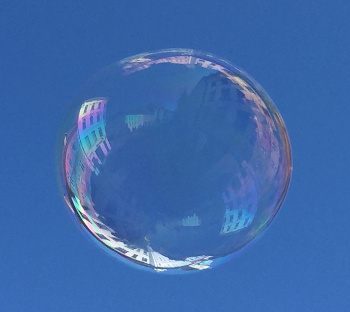
A large soap bubble reflecting a streetscape in Ljubljana, Slovenia.
Soap bubbles containing glycerine have a longer lifetime, since the glycerine molecules have a low vapor pressure, and they're hydrogen-bonded to the water molecules. For those reasons, they slow water evaporation.
(Wikimedia Commons image by P.L. Bechly.)
Bubble
properties go beyond their mere
entertainment value, and they have been the topic of many
scientific studies. As I wrote in a
previous article (Cavitation, October 16, 2017), bubbles can
damage tough metallic components by a process called
cavitation.
Mechanical forces acting on a
liquid can create bubbles through a rapid decrease in
pressure; and, when this is followed by a a rapid change to higher pressure, these bubble will
implode to generate an
intense shock wave.
While the term, cavitation, wasn't used until 1893,[1]
Leonhard Euler (1707-1783) was the first to discuss cavitation in his 1754
paper, "Théorie plus complette des machines qui sont mises en mouvement par la réaction de l'eau (A more complete
theory of machines that are set in
motion by reaction with water).[2] The
physics of cavitation was investigated in 1917 by
Rayleigh, who analyzed the
implosion of a
void in a large
mass of liquid.[3] This study led to the
Rayleigh–Plesset equation, which is an
ordinary differential equation describing the
dynamics of cavitation for
spherical bubbles. Since the bubbles are
nucleated on a
surface, their
shape is actually more like a
hemisphere; so, this might be the most apt reference to a
spherical cow model.
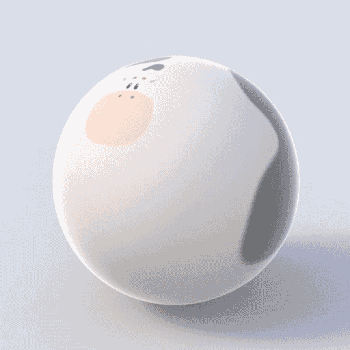
If you don't look too closely, a cow is topologically equivalent to a sphere.
I do a spherical cow calculation before I attempt an experiment, since my equipment might not be capable of the particular measurement task.
(Wikimedia Commons image, original by Keenan Crane, modified.)
Soap bubbles lose water by evaporation; so, it's not surprising that bubbles
cool on their march to
oblivion. At the end of 2022,
solid state physicists from the
Université Paris-Saclay (Orsay, France) examined cooling of soap bubbles and found that their surrounding
soap film can be up to 8
°C cooler than the
environment.[4-5]
In their experiments the French physicists used a fluid mixture of dishwashing liquid, water, and glycerol, similar to the recipe above, and they examined evaporation under different conditions of glycerol
concentration and
relative humidity.[4-5] Not surprisingly, higher glycerol content, which results in a lower water evaporation rate, generated bubble having higher
temperatures.[5] Eight degrees is a significant cooling, and the study
authors write that this cooling needs to be considered in studies of soap film
dynamics, and in the
stability of bubbly
industrial and
consumer products.[4-5]
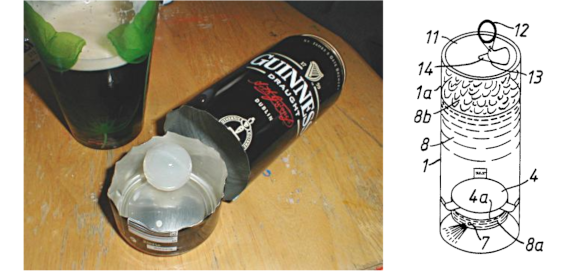
Left, a Guinness widget for canned beer, and figure 5 from the original widget patent. When the can is opened, nitrogen bubbles are released from this device to give a desired foamy beer head.
(Left, a Wikimedia Commons image by Duk. Right, fig. 5 of US Patent no. 4,832,968, "Beverage package and a method of packaging a beverage containing gas in solution," by Alan J. Forage and William J. Byrne, May 23, 1989.[6] Click for larger image.)
A stream of air bubbles in
solution is an excellent source of
agitation. I once
etched prototype copper printed circuit boards in an
aqueous solution of
ferric chloride with an
air plenum that provided agitation bubbles produced by air streaming through
holes. Air bubbles in water are a common way to
clean materials.
Millimeter-sized air bubbles aimed at an
inclined surface will
slide across it and exert a
shear stress that causes
contaminants on the
surface to be removed.[7] The important
parameter of this process is the
tangential speed of the bubble with respect to the surface,
divided by the thickness of the thin layer of liquid separating the bubble and the
solid surface.[7]
Engineers from
Cornell University (Ithaca, New York) have recently
published results of their
experiments on this process with a goal of finding the optimal
impact angle for best cleaning of contaminated surfaces.[7-8] In their experiments, they coated some
glass microscope slides with
mixtures of
milk- and
flour-based
proteins, and with others, a
biofilm of the
E. coli bacterium.[8] These were subjected to six minute bubble streams at various angles face-down in a water
tank.[8] Cleaning efficacy was measured by the
ratio of
transparency to that of uncontaminated slides.[8]
While the
researchers found that bubbles were effective at cleaning at all angles, the effectiveness of cleaning gradually increased from 5° to 20°, giving an increase of transparency from 70% to about 90%.[8] Larger angles gave less cleaning, with transparency decreasing to about 38% at 40°.[8] The highest cleaning efficacy for
polydisperse bubbles in the range of 0.3-2
millimeters and an average radius of 0.6 millimeters was at an angle of about 22.5°.[7]
The research team created a
simulation of a single air bubble impacting with a clean surface that showed that the shear force of the bubble reaches a maximum at 22.5° and then declined at higher angles.[7-8] The simulation showed that increasing the inclination angle gives a higher bubble speed along the surface, increases the shear force.[8] Increased angle, however, decreases the bubble
buoyant force, and this reduces the time that bubbles are pressed against the surface.[8] These
competingprinciples lead to the optimal cleaning angle of about 22.5°.[8]
One commonly observed bubble
phenomenon is the rising
columns of bubbles in a glass of
carbonated soft drink or
sparkling wine. This phenomenon was
analyzed in a recent paper in
Physical Review Fluids by
fluid mechanics researchers from
Brown University (Providence, Rhode Island) and the
University of Toulouse (Toulouse, France).[9-11] In some such drinks, stable, straight line bubble
chains rise from
nucleation sites, while in other drinks such as soda and beer, the bubbles diverge into
cones (see figure).[9,11] The research team's experiments and simulations show that the type of bubble chain behavior depends on bubble size and the
chemistry of the liquid.[10]
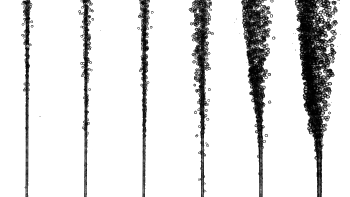
The shape of a bubble stream changes as the rate of bubble injection into a pure liquid increases to that of Champagne.
(Brown University image by Roberto Zenit. Click for larger image.)
In this study, experiments were performed on
Charles de Cazanove Champagne,
San Pellegrino sparkling water,
Tecate beer,and a
Spanish-style
brut.[10-11] A small
rectangular plexiglass container was filled with these fluids, and a
syringe needle at the bottom was used to inject
gas at various
rates to create different kinds of bubble chains.[11] Added
surfactants led to more stable bubble chains, while increased bubble size made the bubble chains more stable, even without surfactants. Most carbonated drinks have small bubbles and few surfactants.[11] Champagne, while having small bubbles, also has a high concentration of surfactants; so, the bubble stream is straight and stable.[10]
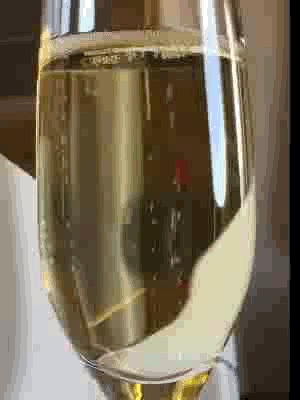
Bubbles in a glass of Champagne, extracted from a Wikimedia Commons video by Subhashish Panigrahi.)
Among the fluid properties the research team measured in their experiments were liquid
density, bubble
radii, bubble paths, and the
fatty acid composition.[10] Their experiments, confirmed by computer simulation, showed that for small bubbles, or for larger bubbles in liquids with low surfactant concentration, the bubbles
shed vortices to form a
pattern in which a leading bubble induces
lateral forces on the trailing bubble, thereby de-stabilizing the chain and developing a
zig-zag path, and the bubble stream becomes a
cone.[10-11] The results of their experiments indicate that Champagne and other sparkling wines in which bubble diameter is small have stable bubble streams because they contain
ingredients that act as surfactants that reduce the
interface tension between the liquid and the gas bubbles.[11]
As
Roberto Zenit, a Brown University
professor of
engineering and one of the paper's authors, explains, "The theory is that in Champagne these contaminants that act as surfactants are the good stuff... These protein
molecules that give
flavor and uniqueness to the liquid are what makes the bubbles chains they produce stable."[11] Some beers also contain surfactant-like molecules, and the bubble streams in these will likewise rise in straight chains.[11] Carbonated water, however, has no such surfactants, and its bubbles will form into a cone.[11]
These research findings are important to understanding such bubbling systems as
ocean seeps, in which
methane and
carbon dioxide bubble from the
ocean floor, and bubble-induced mixing in
aeration tanks at
wastewater treatment facilities.[10-11]
References:
- Shengcai Li, Christopher E. Brennen, and Yoichiro Matsumoto, "Introduction for amazing (cavitation) bubbles," Interface Focus, vol. 5, no. 5 (October 6, 2015), DOI: 10.1098/rsfs.2015.0059.
- L. Euler, "Théorie plus complette des machines qui sont mises en mouvement par la réaction de l'eau," (A more complete theory of machines that are set in motion by reaction with water), Mémoires de l'Académie Royale des Sciences et des Belles Lettres à Berlin, vol. 10 (1754), pp. 227-295 (via Google Books).
- Lord Rayleigh, "On the pressure developed in a liquid during the collapse of a spherical cavity," Phil. Mag., vol. 34, no. 200 (1917), pp. 94-98, doi:10.1080/14786440808635681.
- François Boulogne, Frédéric Restagno, and Emmanuelle Rio, "Measurement of the Temperature Decrease in Evaporating Soap Films," Phys. Rev. Lett., vol. 129, no. 26 (December 23, 2022), Article no. 268001, DOI:https://doi.org/10.1103/PhysRevLett.129.268001.
- Anna Napolitano, "Bubbles Have an Unexpected Chill," Physics. vol. 15, no. s173 (December 19, 2022).
- Alan J. Forage and William J. Byrne, "Beverage package and a method of packaging a beverage containing gas in solution," US Patent no. 4,832,968, May 23, 1989.
- Alireza Hooshanginejad, Timothy Sheppard, Purui Xu, Janeth Manyalla, John Jaicks, Ehsan Esmaili, and Sunghwan Jung, "Effect of angle in removing proteins or bacteria on a tilted surface using air bubbles,"
Phys. Rev. Fluids, vol. 8, no. 4 (April 28, 2023), Article no. 043602, DOI:https://doi.org/10.1103/PhysRevFluids.8.043602.
- Mark Buchanan, "The Optimal Angle for Cleaning with Bubbles," Physics. vol. 16, no. 71 (April 28, 2023).
- Omer Atasi, Mithun Ravisankar, Dominique Legendre, and Roberto Zenit, "Presence of surfactants controls the stability of bubble chains in carbonated drinks," Phys. Rev. Fluids, vol. 8, no. 5 (May 3, 2023), Article no. 053601, DOI:https://doi.org/10.1103/PhysRevFluids.8.053601.
- Katherine Wright, "Straight Lines for Champagne; Wonky Ones for Cola," Physics, vol. 16, no. s67 (May 3, 2023).
- Why do Champagne bubbles rise the way they do?, Brown University Press Release, May 3, 2023 .
Linked Keywords: Grandchild; grandchildren; backyard; bubble (physics); summer months; adult life; baby boomer; my generation; Billboard Hot 100; hit; Tiny Bubbles; Hawaiian; singing; singer; Don Ho (1930-2007); Silent Generation; earlier generation; Lawrence Welk; machine; waft; wafted; stream; bandstand; visual perception; reinforcement; television program; television show; Champagne; Music; tagline; recipe; aqueous solution; cup; dishwashing liquid; tablespoon; glycerine; glycerol; gallon; water; evaporation; lifetime; soap bubble; reflection (physics); reflecting; landscape; streetscape; Ljubljana; Slovenia; molecule; vapor pressure; hydrogen bond; hydrogen-bonded; water; Wikimedia Commons; P.L. Bechly; materials properties; entertainment; science; scientific studies; damage; toughness; tough; metal; metallic; component; cavitation; mechanics; mechanical; force; liquid; pressure; implosion (mechanical process); implode; intensity (physics); intense; shock wave; Leonhard Euler (1707-1783); academic publishing; paper; theory; motion (physics); physics; John William Strutt, 3rd Baron Rayleigh; implosion (mechanical process); void (composites); mass; Rayleigh–Plesset equation; ordinary differential equation; dynamics (mechanics); sphere; spherical; nucleation; nucleate; surface; geometry; shape; hemisphere; spherical cow model; cattle; cow; topology; topologically equivalent; experiment; laboratory equipment; measurement; Keenan Crane; cooling; cool; oblivion; solid-state physics; solid state physicist; Université Paris-Saclay (Orsay, France); soap; coating; film; Celsius; °C; environment (biophysical); concentration; relative humidity; temperature; author; dynamics (mechanics); chemical stability; industry; industrial; consumer; product (business); Guinness; widget (beer); drink can; canned; beer; patent; nitrogen; foam; foamy; beer head; Duk; agitator (device); agitation; etching (microfabrication); etched; prototype; copper; printed circuit board; iron(III) chloride; ferric chloride; plenum chamber; air plenum; hole; cleaning; clean; material; millimeter-sized; inclined plane; inclined surface; sliding (motion); slide; shear stress; contamination; contaminant; surface; parameter; tangent; tangential; speed; ratio; divide; solid; engineer; Cornell University (Ithaca, New York); scientific literature; publish; experiment; impact (mechanics); angle; glass; microscope slide; mixture; milk; flour; protein; biofilm; Escherichia coli; E. coli bacterium; storage tank; transparency; researcher; dispersity; polydisperse; millimeter; computer simulation; buoyancy; buoyant force; competition; competing; scientific law; principle; phenomenon; column; carbonation; carbonated; soft drink; sparkling wine; analysis; analyze; Physical Review Fluids; fluid mechanics; Brown University (Providence, Rhode Island); University of Toulouse (Toulouse, France); chain; nucleation; nucleation site; cone; chemistry; frequency; rate; injection; impurity; pure; liquid; Champagne; Roberto Zenit; Charles de Cazanove; San Pellegrino sparkling water; Tecate beer; Spain; Spanish; brut; cuboid; rectangular; poly-(methyl methacrylate); plexiglass; container; syringe (Laboratory application); syringe needle; gas; rate (mathematics); surfactant; Champagne flute; glass; Subhashish Panigrahi; density; radius; radii; fatty acid; chemical composition; vortex shedding; vortices; pattern; lateral; zig-zag path; ingredients; interface (matter); tension (physics); professor; engineering; molecule; flavor; cold seep; ocean seep; methane; carbon dioxide; seabed; ocean floor; aeration; tank (container); wastewater treatment facility.